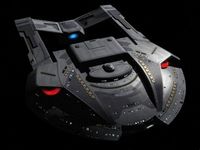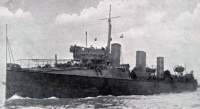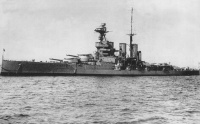Previous ships called Tiger: Difference between revisions
m (→[[wp:HMS Tiger (1913)|HMS Tiger]]: ...yes, the same Hood that was sunk by the Bismarck) |
mNo edit summary |
||
| Line 25: | Line 25: | ||
===HMS Tiger=== | ===HMS Tiger=== | ||
wooden-hulled paddle sloop launched in 1849, reclassified as a frigate in 1852, and lost in action at Odessa in 1854 | wooden-hulled paddle sloop launched in 1849, reclassified as a frigate in 1852, and lost in action at Odessa in 1854 | ||
===[[wp:SMS Tiger (1887)|SMS Tiger]]=== | |||
===SMS Tiger=== | ===SMS Tiger=== | ||
German. Iltis class gunboat, launched 15 August 1899, commissioned 3 April 1900, scuttled 29 October 1914 | German. Iltis class gunboat, launched 15 August 1899, commissioned 3 April 1900, scuttled 29 October 1914 | ||
Revision as of 10:25, 19 November 2008
| This article is in need of attention. Please improve it in any way you see fit. |
HMS Tiger
A destroyer of the Royal Navy rated at 380 tons, this HMS Tiger is best known for its unfortunate demise. Launched in 1900, the Tiger was part of a short exercise in 1908, involving a home fleet based at Portsmouth and an attacking destroyer fleet, of which Tiger was a member. The two fleets met at night, but the exercise went badly wrong as the HMS Berwick rammed the Tiger, splitting the destroyer in half. Tiger sunk in just three minutes off the coast of St. Catherine's Point, Isle of Wight, with the loss of 35 lives, including commanding officer Lt.Cmdr Middleton. 22 of the crew were rescued.
HMS Tiger
- "Quis Eripet Dentes" ("Who will draw my teeth?")
A battlecruiser of the Royal Navy, this Tiger was constructed in Clydebank, near Glasgow, Scotland by the same company who were later responsible for the ocean liner Queen Elizabeth 2 (QE2). Construction began in June 1912 and the ship was launched in December of the following year. Despite originally being planned as part of the Lion class, she was redesigned at an early stage as a unique vessel. She was the United Kingdom's most heavily armoured battlecruiser upon the outbreak of World War I in 1914.
Although launched in 1913, HMS Tiger was not ready for commissioning until October 1914; a couple of months after the start of the war. She was quickly pressed into combat however, as Tiger was part of the British fleet at the Battle of Dogger Bank in January 1915. Although the British won the battle, Tiger's inexperienced crew scored just 1 hit from 255 shells fired; her gunnery officer sacked afterwards as a result. The ship performed better at the Battle of Jutland the following year; the largest Naval battle in Earth history. However, Tiger was fortunate to survive the conflict, being hit no fewer than 15 times by shells at Jutland alone.
Tiger stayed in service after World War I, but the political climate was to cause its demise. Having survived the naval forces reductions of the 1922 Washington Naval Treaty, Tiger was reassigned as a training vessel. It briefly returned to active service in 1929 as the HMS Hood began a refit, but the death knell was rung by the London Naval Treaty in 1930. Tiger was decommissioned as soon as the Hood's refit had been completed; the Tiger broken up as scrap in 1931.
HMS Tiger (C50)
- Renamed HMS Bellerophon, HMS Blake, then HMS Bellerophon before being scrapped incomplete.
HMS Tiger (C99)
- Renamed from HMS Blake. Renamed to HMS Blake prior to launch
HMS Tiger (C20)
- "Quis Eripet Dentes" ("Who will draw my teeth?")
- Renamed from HMS Bellerophon (confused yet?)



